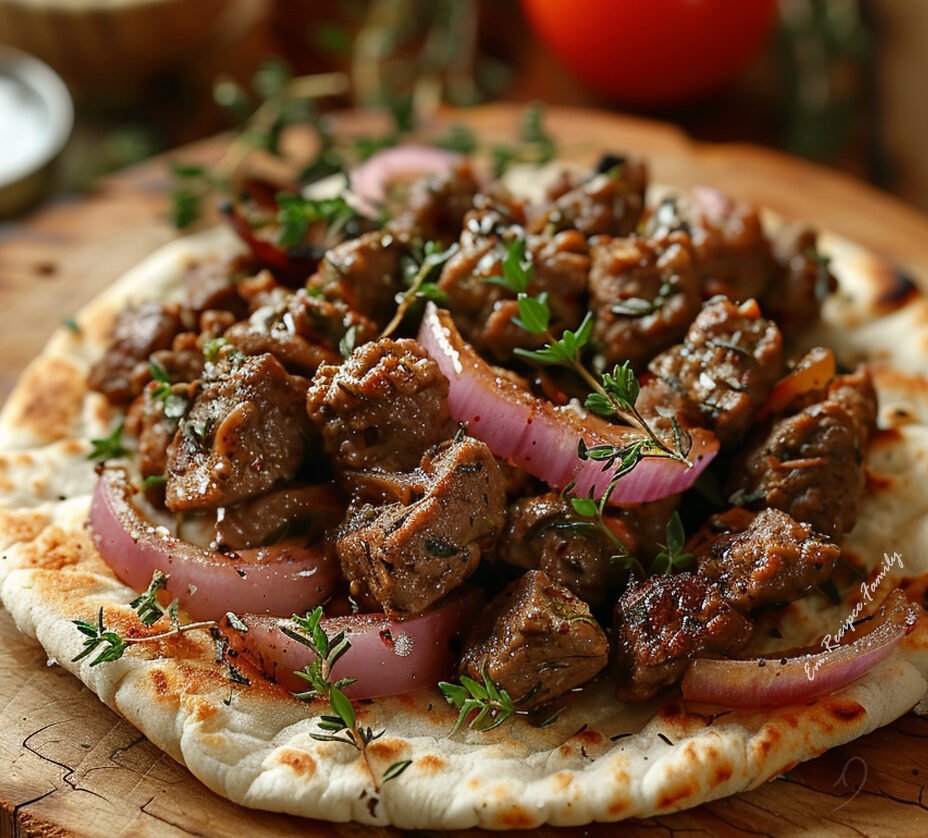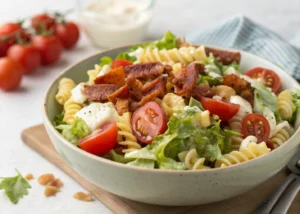
Craving that irresistible, thinly sliced, savory gyro meat from your favorite Mediterranean spot? Now you can recreate that authentic flavor right in your own kitchen with this incredible Traditional Gyro Meat recipe! Combining seasoned ground lamb and beef, infused with classic Mediterranean herbs, then baked to perfection in a loaf pan, this recipe delivers tender, flavorful meat that’s perfect for building classic gyro sandwiches. It’s a true labor of love that’s simpler to make than you might think, and the result is miles beyond anything store-bought!
Why I Love This Recipe
Making your own gyro meat at home is incredibly rewarding, and this recipe is a favorite for several reasons. What I love most is the ability to control the ingredients and achieve that perfect, restaurant-quality flavor. The blend of ground lamb and beef creates a rich, authentic taste, while the combination of garlic, oregano, cumin, marjoram, rosemary, and thyme infuses the meat with a deeply aromatic profile. Baking it in a loaf pan with a water bath ensures it cooks evenly and stays incredibly moist, allowing you to get those beautifully thin slices. It’s a hearty, satisfying dish that transforms a simple meal into an exciting culinary experience!
Ingredients
Here’s what you’ll need to craft your own delicious Traditional Gyro Meat:
- ½ medium onion, cut into chunks
- 1 pound ground lamb
- 1 pound 80/20 ground beef
- 1 tablespoon minced garlic
- 1 teaspoon dried oregano
- 1 teaspoon ground cumin
- 1 teaspoon dried marjoram
- 1 teaspoon ground dried rosemary
- 1 teaspoon ground dried thyme
- 1 teaspoon ground black pepper
- 1½ teaspoons fine sea salt
- Cooking spray
Swaps and Notes
- Onion: A yellow or sweet onion works well here. Finely mincing and squeezing out liquid is crucial for texture.
- Ground Lamb: Lamb is traditional and gives gyro meat its distinctive flavor.
- 80/20 Ground Beef: This fat content is important for moisture and flavor. Leaner beef can result in drier gyro.
- Garlic: Freshly minced garlic provides the best flavor.
- Herbs and Spices: The combination of dried oregano, cumin, marjoram, rosemary, and thyme is essential for the authentic Mediterranean flavor. Ensure your dried herbs are fresh for maximum potency. Ground versions are specified here for even distribution.
- Fine Sea Salt: Fine sea salt dissolves well and seasons evenly.
- Cooking Spray: For greasing the loaf pan.
Directions
Let’s get this authentic Traditional Gyro Meat cooking!
- Prepare the Onion: Gather all your ingredients. Take the half medium onion, cut into chunks, and place it in a food processor. Pulse until the onion is very finely chopped, typically about 5 (1-second) pulses. You want it finely minced, not puréed. Scoop the finely chopped onions onto the center of a clean kitchen towel. Gather up the towel ends and squeeze very firmly to remove as much liquid as possible from the onions. This step is critical to prevent the gyro meat from being watery.
- Combine Meat Mixture: In a large mixing bowl, combine the squeezed, finely chopped onions, 1 pound of ground lamb, 1 pound of 80/20 ground beef, 1 tablespoon of minced garlic, 1 teaspoon of dried oregano, 1 teaspoon of ground cumin, 1 teaspoon of dried marjoram, 1 teaspoon of ground dried rosemary, 1 teaspoon of ground dried thyme, 1 teaspoon of ground black pepper, and 1½ teaspoons of fine sea salt. Use your hands to mix until all the ingredients are very well combined.
- Refrigerate to Blend Flavors: Cover the bowl tightly with plastic wrap and refrigerate the meat mixture for 1 to 2 hours. This allows the flavors to blend and deepen, contributing to the final taste of the gyro meat.
- Preheat Oven & Prep Loaf Pan: Preheat your oven to 325 degrees F (165 degrees C). Evenly coat a 9×5-inch loaf pan generously with cooking spray.
- Process Meat for Texture: Working in 2 batches if necessary (depending on your food processor size), place the refrigerated meat mixture into the food processor. Pulse until the mixture is very finely chopped and the texture feels tacky or pasty, about 1 minute per batch. This process helps create the characteristic cohesive, slightly compressed texture of gyro meat.
- Pack Loaf Pan: Transfer the finely processed meat mixture into the prepared loaf pan. Pack it down very firmly, pressing out any air pockets. You want a dense, solid loaf.
- Prepare Water Bath: Line a medium roasting pan (large enough to hold the loaf pan) with a damp kitchen towel. Place the meat-filled loaf pan in the center of the towel-lined roasting pan. Carefully transfer the roasting pan into the preheated oven. Once in the oven, carefully pour boiling water into the roasting pan until it comes halfway up the sides of the loaf pan. This water bath helps the gyro meat cook evenly and stay moist.
- Bake: Bake in the preheated oven for about 1 hour to 1 hour 25 minutes, or until the gyro meat is no longer pink in the center. To ensure it’s safely cooked, an instant-read thermometer inserted into the center of the loaf should read at least 160 degrees F (70 degrees C).
- Cool and Serve: Carefully remove the loaf pan from the roasting pan. Pour off any accumulated fat from the loaf pan. Allow the gyro meat to cool slightly in the loaf pan before carefully removing it onto a cutting board. Slice thinly (a very sharp knife or electric slicer works best here) and serve immediately.
Tips for Success
- Squeeze Onion Dry: This is critical! Excess moisture from the onion will make your gyro meat soggy. Squeeze out as much liquid as possible.
- Process Meat: Don’t skip the food processor step after the initial mix. This is how you achieve that authentic, slightly compressed and finely textured gyro meat.
- Pack Firmly: When transferring the meat to the loaf pan, pack it down very tightly to eliminate air pockets. A dense loaf holds together well for slicing.
- Water Bath: The water bath is essential for moist, evenly cooked gyro meat.
- Internal Temperature: Always use a meat thermometer to ensure the gyro meat is cooked to a safe internal temperature of 160°F (70°C).
- Thin Slicing: Gyro meat is traditionally sliced very thinly. A sharp carving knife or an electric slicer will give you the best results.
Serving Suggestions and Pairings
Traditional Gyro Meat is the star of the show, typically served in a specific way:
- Pita Bread: Serve thin slices of warm gyro meat in soft, warmed pita bread.
- Tzatziki Sauce: A creamy cucumber-yogurt sauce (Tzatziki) is the classic accompaniment.
- Fresh Toppings: Load up your gyro with sliced tomatoes, thinly sliced red onion, and fresh chopped lettuce.
- Fries: A side of crispy French fries or our Crispy Sweet Potato Fries would be a delicious addition.
- For other savory, hearty dishes perfect for sharing, consider our Jalapeño and Pepper Jack Summer Sausage for another homemade meat specialty.
Storage and Leftover Tips
Homemade gyro meat is excellent for making ahead and enjoying over several days.
- Refrigeration (Cooked): Store cooled, sliced gyro meat in an airtight container in the refrigerator for up to 3-4 days.
- Freezing (Cooked): Cooked and cooled gyro meat (whole loaf or sliced) freezes very well. Wrap tightly in plastic wrap, then aluminum foil, and freeze for up to 3 months.
- Reheating: To reheat sliced gyro meat, pan-fry in a hot skillet with a little oil until warmed through and slightly crispy, mirroring how it’s cooked on a vertical spit. You can also warm it in the oven.
More Recipes You Will Love
If you loved the savory, hearty, and authentic nature of this Traditional Gyro Meat, you’ll definitely want to explore some of our other fantastic, fuss-free recipes:
- For another fantastic skillet meal with Southern flair, try This Tomato Skillet with Okra and Sausage Is My Favorite Quick Dinner Packed with Southern Flavor.
- If you’re a fan of rich, aromatic rice dishes, our Afghani Kabuli Pulao with Lamb Shanks is a must-try.
- And for a hearty one-pan meal with a Tex-Mex twist, our Mexican Chicken and Rice Casserole Is My Favorite One-Pan Dinner That’s Always a Hit is a winner.
- Finally, for a fun, interactive meal that’s perfect for feeding a crowd, don’t miss our Walking Taco Bar Is My Favorite No-Fuss Way to Feed a Crowd!
Final Thoughts
This Traditional Gyro Meat recipe is a brilliant way to bring the authentic flavors of the Mediterranean to your home kitchen. It’s a rewarding project that yields incredibly tender, flavorful meat, perfect for creating delicious gyro sandwiches that will transport you to a bustling street market.
Give this recipe a try and experience the joy of homemade gyro! What’s your favorite way to enjoy a gyro? Share your ideas in the comments below!




Leave a Reply